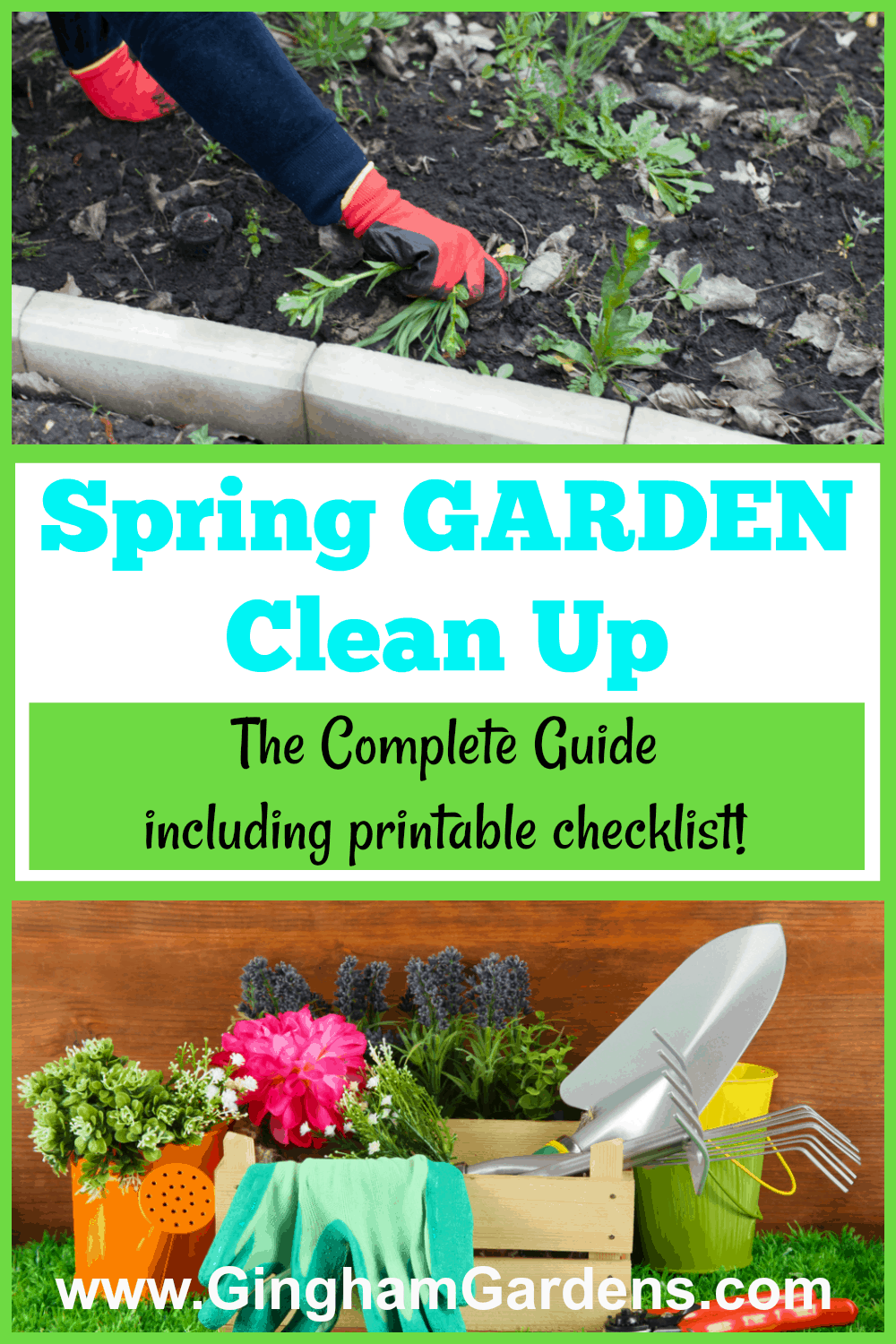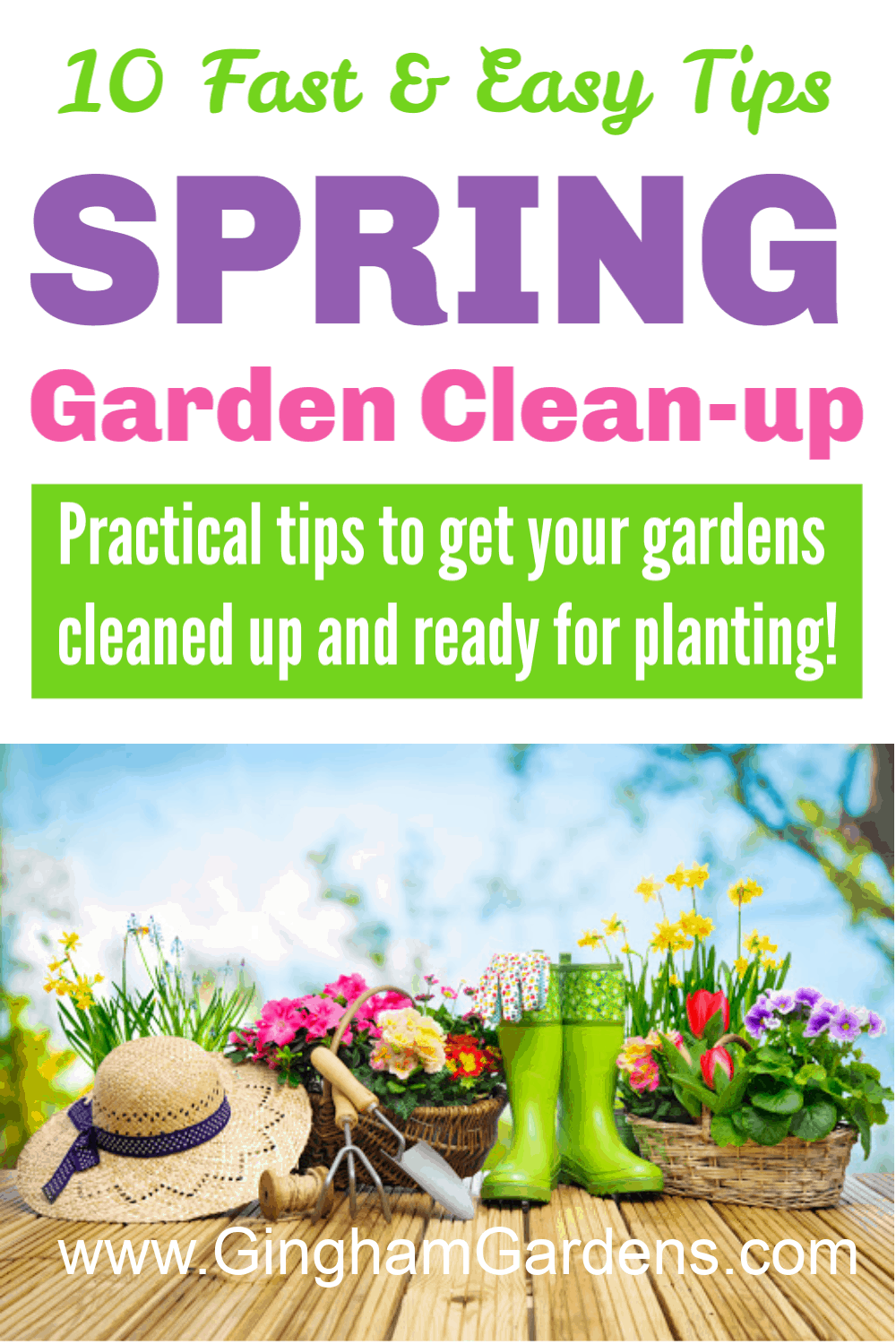Practical Tips for Spring Garden Clean Up
Oh my goodness, you guys, Spring Garden Cleanup is awesome! Yep, I know I’m crazy, but I really do love it. After being cooped up indoors all winter, getting to putter and work outside is literally a breath of fresh air and such an exciting time of year. The sounds of the birds chirping and nature waking up after it’s long winter sleep are just music to my ears. I get downright giddy seeing all my little plants popping up out of the soil and all of the new growth. It’s magical and I don’t even mind the work that comes with it. Come on, I’m not the only one – what about you, do you enjoy springtime garden cleanup too?
When to Start Spring Garden Cleanup
Every year the spring equinox (the first day of spring) falls on or around March 20th. I’m in gardening zone 4b/5a, many of you are in different gardening zones, and spring weather doesn’t always follow the calendar. It’s best for you to determine, by watching your local extended weather forecast, when spring has arrived in your area. I generally try to wait until nighttime temps are consistently in the 50s (fahrenheit) and the daytime temperatures are in the upper 50s and 60s. It’s important for soil temperatures to be in the 50s too.
Don’t dive in to early though! The leftover leaves and mulch from last fall help to protect emerging perennials and if removed too early, can subject the plants to frost or freeze damage. Perennials will usually recover from damage done by frost or a hard freeze, just don’t get too overzealous. Also, you don’t want to go tromping around in your garden beds and compacting damp soil.
It’s also important to note that native bees, beneficial insects and pollinators overwinter in garden debris and hollow stems and it’s best not to wake them up too soon. Even if you see pollinators out and about on warm days, they still need hiding places for cool nights. Just be sure to leave a few leaf or garden debris piles in your yard for your little pollinator friends. It differs from one area to another, so you have to be the judge of the right time to start cleaning up your gardens in spring.
Spring Cleaning for the Garden – Get Organized
There are many things that can be done in late winter and early spring even before we can work in our gardens.
- Seed Starting Indoors is an awesome way to get your hands in some dirt and get a jump start on spring gardening.
- Garden Planning. Do you have notes from last year? If so, pull them out and start making plans for this year.
- Now is also the best time to plan a new garden bed, or garden projects.
- Make lists. If you haven’t already done so, check out the Free Gardening Printables – Resources Library. I start my lists by going through each area or flower bed, and making notes on what needs to be done. This task can be done early on when it’s still too wet or cold to actually do any work. There’s also a Spring Garden Checklist available in the gardening resources library too. Get immediate access to the printables by completing the form below.
A Few More Gardening Tasks for Early Spring Cleanup:
If you can’t stand the wait and need to get outdoors, here are a few ideas of things you can do to keep you busy:
- Do a yard tidy up by picking up dead branches and sticks.
- Have a dog? You know what needs to be done.
- Gather soil for a soil test. If you haven’t ever done this, do a little internet research for your local county extension office, or local university that does soil testing.
This post contains affiliate links. If you click on
one of the links and make a purchase,
I may receive a small commission at no additional cost to you.
See full disclosure here.
Spring To Do List For the Garden
The best way to stay focused is to go through each flower bed or garden area, one at a time:
- Cut down dead plants, including perennials and ornamental grasses, that weren’t cut back last fall.
- Pull any visible weeds or leftover dead annuals. Spring is the perfect time to get a head start on weeds.
- Clean up all leaf litter, dead foliage and plant debris. It’s a good idea to lightly rake large areas. Use a leaf rake – this one is so awesome, because it’s adjustable and makes it easy to get into tight spots. I pick up leaves and debris by hand around early emerging plants and spring bulbs (like tulips and daffodils). If you’re somewhat new to gardening, you’ll learn that most perennials are fairly tough and resilient plants and raking over them lightly won’t hurt them.
- Many gardeners leave the leaves on their garden beds to break down and fortify the soil. I prefer a little more tidy look, but whether or not to rake is up to each individual gardener. It’s not going to hurt anything if you rake and it’s not going to hurt anything if you don’t.
- I add the leaves and debris to the compost pile. Dead leaves come in really handy in the summer when everything is green and I need brown to add to the compost bin. Compost is the best way to add organic matter to your garden beds and improve your soil. If you don’t compost, bag up the yard and garden debris and take it to your local compost site.
More Spring Cleanup Tasks for the Garden
- I like to go through my perennial beds and survey any damage, taking notes of the plants that did not make it through the winter. Just a note here, some perennials (like balloon flower (platycodon) and blanket flower (gaillardia) to name a few) are very slow to emerge in spring. I usually wait a week or two or three (depending on the weather) after my first walkabout before I decide which plants really did not survive the winter. I then compare my notes with notes I made last fall and decide what new plants I’m going to purchase, or what plants I’m going to move around.
- Before plants fill in, spring is the perfect time to assess any damage to irrigation lines and replace or repair them. I don’t have irrigation in place in my gardens, but this spring I will be adding this simple drip irrigation system to some of my flower beds.
- Replace plant tags that are damaged, or swallowed up by the raking process. My favorite plant tags are made from old cut-up mini blinds. The aluminum ones work the best. They will bend when raked over, but won’t break. Next time you happen to be at a thrift store, keep an eye out for a cheap mini blind. I use fancier plant labels like this for my daylilies, just because my daylilies are special! Be sure to write with a good paint marker that will stand up to weather elements for a long while.
- Spring is a great time to Transplant and Divide Perennials too. The plants recover quicker from transplant shock when the temps are still relatively cool.
The Best Gardening Tools and Supplies:
Early spring before you can actually get in your gardens, is a great time to clean out your garden shed. Clean up and sharpen tools that you didn’t get to last fall. Are there tools that need to be replaced? Go through your gardening supplies, as well, and make a list of what you need.
Some of my favorite gardening tools:
Spring Garden Plans
If you haven’t already taken the time to plan out new gardening projects, now is a good time to do that. If you’re relatively new to gardening, make sure to read the posts, Flower Gardening 101 and Vegetable Gardening 101. I think you’ll find both those articles helpful. If you need some spring garden ideas, or just need some Flower Garden Eye Candy, check out The Best Spring Flowers and Tips for Growing Them. Another great spring post is Early Spring Garden Ideas.
I have so many gardening ideas and projects running through my head that this is when I have to slow down and reign myself in. It just can’t all be done in one season – gardening is a process. I’m using a Garden Project Checklist that I put together that helps me focus on what I want to accomplish in my gardens. It’s available in the Free Gardening Printables Resource Library.
More Spring Gardening Tips – How to Shop for Flowers & Plants
When the gardening beds are all cleaned up, perennials are starting to emerge and the weather is cooperating, it’s time to go plant shopping. First though, make a list. I will admit that when it comes to plant shopping, I’m not always the most organized and I tend to go a little crazy. Here’s where it’s good to have a budget in mind too. And, that coming from a girl who would spend her last dollar on flowers. When I do have to keep my spending in check, I don’t even take a purse into the nursery. Really, I just carry my allotted amount of cash in my pocket and that keeps me from going crazy.
A good tip to remember when buying flowers (both annuals and perennials) is to look for garden plants that are full of buds, not blooms. If you purchase plants that are full of flowers with no buds, in a week or so they’ll poop out and you’ll have to wait for a new round of blooms. We have a complete article with lots of great tips on Plant Shopping.
Spring garden cleanup is one of the best things we can do to ensure a successful gardening season. So, dig in (pun intended) and get your spring garden cleanup done. Once we get warmer weather and the growing season is in full swing, it will be busy and you’ll be glad you took the time to get them going right.
Have you done your Spring Garden Clean Up yet? Or, are you just waiting for spring to come like I am? I just keep making plans, planting seeds indoors, potting up bulbs indoors, and dreaming of warmer, brighter days.
Happy gardening,
Joanna
p.s. Feel free to save the pins below to your favorite gardening board on Pinterest. If you hover in the upper left-hand corner of the picture, you’ll see the little Pinterest icon. Just click it and pin away. There are more pins to share below.
p.p.s I’d love to have you follow me on Pinterest. Lots of great gardening ideas and tons of gardener’s eye candy. Gingham Gardens is also on Facebook.
Pins to share:



